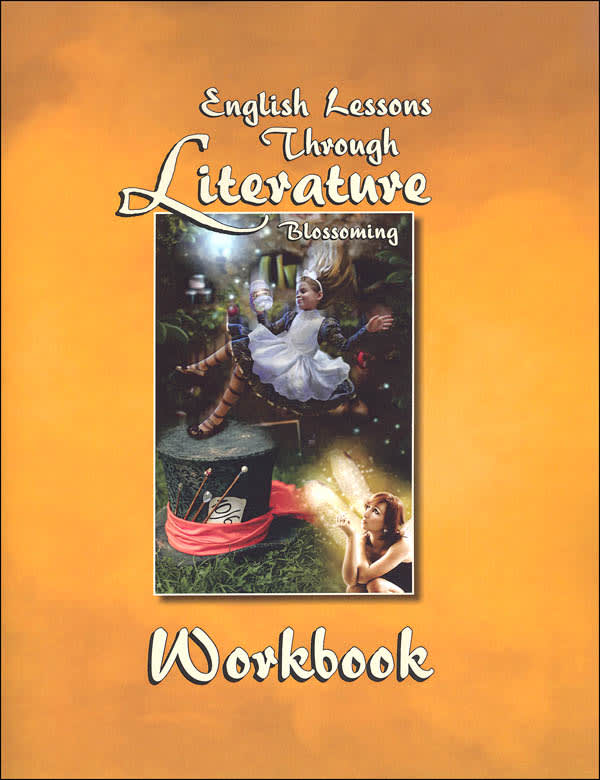"Through literature" is the operative phrase
in this series, a Charlotte Mason approach to language arts skills. Together the
teacher and student travel through literature - poetry, well-loved books,
fables, and stories. You pause along the way, of course, taking time to
appreciate the story and learn the grammatical structure of the English
language, giving the student opportunity through copywork (a Commonplace book
replaces this in Levels F and up), some narration, and working slowly through
the Progymnasmata methods to become immersed in quality writing models. Picture
studies complement the literature and provide the means for students to put
their thoughts into words and develop their observation skills. Just for good
measure, the author has included some memory work grammatical lists and
definitions. Taken altogether, the result is an easy-to-use, holistic approach
to English that is thoroughly consistent with Charlotte Mason, and yet meatier
than some programs with a similar bent. Compared to some, it also has a more
updated "feel" even though many of the literature selections are
"timeless" (i.e. a little old-fashioned).
The eight levels (Aspiring, Blossoming, Cultivating, Discerning, Enlightening, Flourishing, Growing and Harvesting) can be used for grades 1 through 8. The author recommends starting Aspiring in 2nd grade but 1st is also an option. The Volumes are designed for the teacher and provide three lessons per week for 36 weeks (108 lessons per level). Each lesson follows a similar format. In each level, whole books are provided as read-alouds, with chapters to be read daily as the first lesson item. Fables, stories, excerpts, and poetry are also regularly used. Occasionally, the student is asked to think about something from the reading, but the author avoids comprehension questions. The instructional nugget is next and "nugget" does seem like the best description particularly in Aspiring/Blossoming. In the upper levels, the "nugget" is something more like a "chunk."
Systematic grammar instruction starts in Blossoming and is pretty impressive, covering everything from punctuation to parts of speech to types of sentences and includes diagramming beginning in Cultivating. In fact, in Blossoming and up, the lesson title reflects the grammar covered (i.e. #38 in Blossoming is titled State of Being Verbs; Review: Pronouns) leaving no doubts about the general grammatical scope and sequence. In Discerning & Enlightening there is an appendix that provides additional writing lessons for older students. The appendices in each Volume include valuable information – memory work lists, a segment on the correct use of words, diagramming references, and sometimes literature passages as well as additional writing lessons and writing/editing protocol in the upper levels. The author also encourages the use of a personal spelling journal.
Writing instruction incorporates the classical progymnasmata (a bit unusual for a Charlotte Mason program). Aspiring through Flourishing focuses on fables and narrative while Growing explores chreia and maxim.
Workbooks are available for Aspiring through Flourishing and provide all the exercises and copywork. Though technically optional, they are a major time-saver for the teacher. In the lower levels (Aspiring through Discerning) they are available in several handwriting styles (Manuscript, Slant Cursive, Vertical Cursive, Basic Italic, and Cursive Italic). In the Enlightening and Flourishing levels, workbooks are provided in a print font.
There is very little teacher prep in this series. You will want/need to get a copy of the read-aloud books and make a copywork master (if not using the Workbooks), That's about it! The daily lessons are pick-up-and-go. Full-color versions of the picture studies (black and white in the volumes) are available on the author's website, so you may want to provide access to those just to make the whole study more enjoyable for both of you. Your student will ultimately be compiling a notebook to include copywork, definitions, exercise. Although prep is minimal with these courses, the daily lessons are based on teacher-student interaction.
The author considers English Lessons Through
Literature secular but inclusive, pulling readings from
Christian, Buddhist, Taoist, and Jewish writings as well as ancient Greek and
Roman mythology. Since these are included as literature and not as religious
instruction, we at Rainbow consider this curriculum neutral. See each level’s
description for specifics on the specific reading selections.
You can probably tell that we are enthusiastic about this series. It's well-constructed, easy-to-use, has a strong emphasis on literature plus an equally strong emphasis on systematic grammar and mechanics as well as writing skills. You only need to add phonics/reading instruction and perhaps a systematic spelling to have a well-rounded approach to English and Language Arts. The author's series Reading Lessons Through Literature is an excellent complement providing, phonics, spelling, and reading. ~ Janice/Ruth


